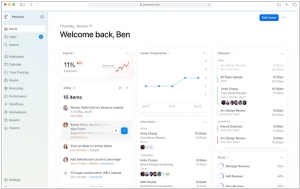Airtable vs AppSheet
October 19, 2024 | Author: Michael Stromann
21★
Part spreadsheet, part database, and entirely flexible, teams use Airtable to organize their work, their way.
12★
Google's AppSheet provides a no-code development platform for application software, which allows users to create mobile, tablet, and web applications using data sources like Google Drive, DropBox, Office 365, and other cloud-based spreadsheet and database platforms.
Airtable and AppSheet are a bit like two particularly peculiar creatures on a distant, fog-covered planet that’s surprisingly good at making lists. Airtable is the friendly, ever-so-charming being that loves nothing more than arranging things in neat, colorful rows and columns. It excels at transforming chaos into an organized, collaborative wonderland, where teams can happily fiddle with data, tweak views and create relationships between bits of information without ever needing to wrestle with anything more complicated than a cup of tea. It’s the sort of tool you’d invite to a quiet evening of project management and perhaps a light bit of relational database tinkering.
AppSheet, on the other hand, is the sort of no-nonsense, buttoned-up creature who likes to roll up its sleeves and get to work building proper, functioning apps that actually *do* things. It’s perfect for those moments when someone says, “Wouldn’t it be splendid if this entire business process could run itself?” and you realize that, yes, it could—if only you had a way to automate workflows and integrate with your existing data in a mobile-friendly, business-solution kind of way. AppSheet doesn’t waste time with frills; it’s there to help you build something practical and it syncs data in real-time, which, frankly, is impressive enough to make your head spin.
Choosing between these two is rather like deciding whether you want a delightful, visually satisfying system for managing information (Airtable) or a more functional, let’s-get-down-to-business app for real-world processes (AppSheet). Both are powerful, but it all comes down to whether you’re in the mood for organizing or inventing. And, possibly, whether you’ve had enough tea.
See also: Top 10 Low-Code Platforms
AppSheet, on the other hand, is the sort of no-nonsense, buttoned-up creature who likes to roll up its sleeves and get to work building proper, functioning apps that actually *do* things. It’s perfect for those moments when someone says, “Wouldn’t it be splendid if this entire business process could run itself?” and you realize that, yes, it could—if only you had a way to automate workflows and integrate with your existing data in a mobile-friendly, business-solution kind of way. AppSheet doesn’t waste time with frills; it’s there to help you build something practical and it syncs data in real-time, which, frankly, is impressive enough to make your head spin.
Choosing between these two is rather like deciding whether you want a delightful, visually satisfying system for managing information (Airtable) or a more functional, let’s-get-down-to-business app for real-world processes (AppSheet). Both are powerful, but it all comes down to whether you’re in the mood for organizing or inventing. And, possibly, whether you’ve had enough tea.
See also: Top 10 Low-Code Platforms





